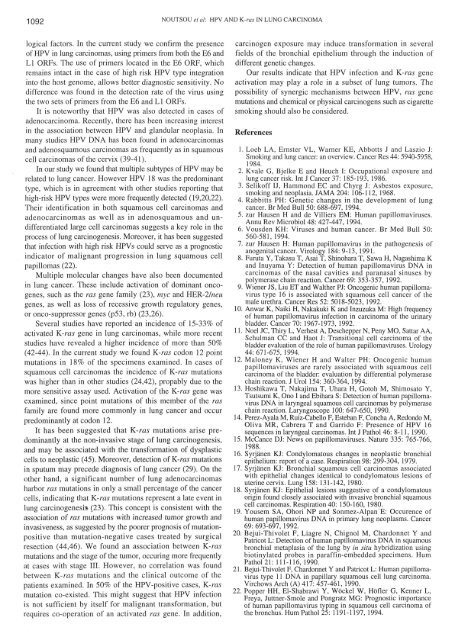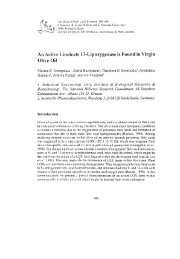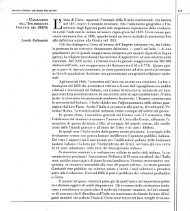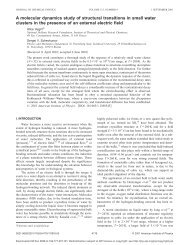Detection of human papilloma virus (HPV) and K-ras mutations in ...
Detection of human papilloma virus (HPV) and K-ras mutations in ...
Detection of human papilloma virus (HPV) and K-ras mutations in ...
Create successful ePaper yourself
Turn your PDF publications into a flip-book with our unique Google optimized e-Paper software.
1092 NOUTSOU et al: <strong>HPV</strong> AND K-<strong>ras</strong> IN LUNG CARCINOMA<br />
logical factors. In the current study we confirm the presence<br />
<strong>of</strong> <strong>HPV</strong> <strong>in</strong> lung carc<strong>in</strong>omas, us<strong>in</strong>g primers from both the E6 <strong>and</strong><br />
LI ORFs. The use <strong>of</strong> primers located <strong>in</strong> the E6 ORF, which<br />
rema<strong>in</strong>s <strong>in</strong>tact <strong>in</strong> the case <strong>of</strong> high risk <strong>HPV</strong> type <strong>in</strong>tegration<br />
<strong>in</strong>to the host genome, allows better diagnostic sensitivity. No<br />
difference was found <strong>in</strong> the detection rate <strong>of</strong> the <strong>virus</strong> us<strong>in</strong>g<br />
the two sets <strong>of</strong> primers from the E6 <strong>and</strong> LI ORFs.<br />
It is noteworthy that <strong>HPV</strong> was also detected <strong>in</strong> cases <strong>of</strong><br />
adenocarc<strong>in</strong>oma. Recently, there has been <strong>in</strong>creas<strong>in</strong>g <strong>in</strong>terest<br />
<strong>in</strong> the association between <strong>HPV</strong> <strong>and</strong> gl<strong>and</strong>ular neoplasia. In<br />
many studies <strong>HPV</strong> DNA has been found <strong>in</strong> adenocarc<strong>in</strong>omas<br />
<strong>and</strong> adenosquamous carc<strong>in</strong>omas as frequently as <strong>in</strong> squamous<br />
cell carc<strong>in</strong>omas <strong>of</strong> the cervix (39-41).<br />
In our study we found that multiple subtypes <strong>of</strong> <strong>HPV</strong> may be<br />
related to lung cancer. However <strong>HPV</strong> 18 was the predom<strong>in</strong>ant<br />
type, which is <strong>in</strong> agreement with other studies report<strong>in</strong>g that<br />
high-risk <strong>HPV</strong> types were more frequently detected (19,20,22).<br />
Their identification <strong>in</strong> both squamous cell carc<strong>in</strong>omas <strong>and</strong><br />
adenocarc<strong>in</strong>omas as well as <strong>in</strong> adenosquamous <strong>and</strong> undifferentiated<br />
large cell carc<strong>in</strong>omas suggests a key role <strong>in</strong> the<br />
process <strong>of</strong> lung carc<strong>in</strong>ogenesis. Moreover, it has been suggested<br />
that <strong>in</strong>fection with high risk <strong>HPV</strong>s could serve as a prognostic<br />
<strong>in</strong>dicator <strong>of</strong> malignant progression <strong>in</strong> lung squamous cell<br />
<strong>papilloma</strong>s (22).<br />
Multiple molecular changes have also been documented<br />
<strong>in</strong> lung cancer. These <strong>in</strong>clude activation <strong>of</strong> dom<strong>in</strong>ant oncogenes,<br />
such as the <strong>ras</strong> gene family (23), myc <strong>and</strong> HER-2/new<br />
genes, as well as loss <strong>of</strong> recessive growth regulatory genes,<br />
or onco-suppressor genes (p53, rb) (23,26).<br />
Several studies have reported an <strong>in</strong>cidence <strong>of</strong> 15-33% <strong>of</strong><br />
activated K-<strong>ras</strong> gene <strong>in</strong> lung carc<strong>in</strong>omas, while more recent<br />
studies have revealed a higher <strong>in</strong>cidence <strong>of</strong> more than 50%<br />
(42-44). In the current study we found K-<strong>ras</strong> codon 12 po<strong>in</strong>t<br />
<strong>mutations</strong> <strong>in</strong> 18% <strong>of</strong> the specimens exam<strong>in</strong>ed. In cases <strong>of</strong><br />
squamous cell carc<strong>in</strong>omas the <strong>in</strong>cidence <strong>of</strong> K-<strong>ras</strong> <strong>mutations</strong><br />
was higher than <strong>in</strong> other studies (24,42), propably due to the<br />
more sensitive assay used. Activation <strong>of</strong> the K-<strong>ras</strong> gene was<br />
exam<strong>in</strong>ed, s<strong>in</strong>ce po<strong>in</strong>t <strong>mutations</strong> <strong>of</strong> this member <strong>of</strong> the <strong>ras</strong><br />
family are found more commonly <strong>in</strong> lung cancer <strong>and</strong> occur<br />
predom<strong>in</strong>antly at codon 12.<br />
It has been suggested that K-<strong>ras</strong> <strong>mutations</strong> arise predom<strong>in</strong>antly<br />
at the non-<strong>in</strong>vasive stage <strong>of</strong> lung carc<strong>in</strong>ogenesis,<br />
<strong>and</strong> may be associated with the transformation <strong>of</strong> dysplastic<br />
cells to neoplastic (45). Moreover, detection <strong>of</strong> K-<strong>ras</strong> <strong>mutations</strong><br />
<strong>in</strong> sputum may precede diagnosis <strong>of</strong> lung cancer (29). On the<br />
other h<strong>and</strong>, a significant number <strong>of</strong> lung adenocarc<strong>in</strong>omas<br />
harbor <strong>ras</strong> <strong>mutations</strong> <strong>in</strong> only a small percentage <strong>of</strong> the cancer<br />
cells, <strong>in</strong>dicat<strong>in</strong>g that K-<strong>ras</strong> <strong>mutations</strong> represent a late event <strong>in</strong><br />
lung carc<strong>in</strong>ogenesis (23). This concept is consistent with the<br />
association <strong>of</strong> <strong>ras</strong> <strong>mutations</strong> with <strong>in</strong>creased tumor growth <strong>and</strong><br />
<strong>in</strong>vasiveness, as suggested by the poorer prognosis <strong>of</strong> mutationpositive<br />
than mutation-negative cases treated by surgical<br />
resection (44,46). We found an association between K-<strong>ras</strong><br />
<strong>mutations</strong> <strong>and</strong> the stage <strong>of</strong> the tumor, occur<strong>in</strong>g more frequently<br />
at cases with stage III. However, no correlation was found<br />
between K-<strong>ras</strong> <strong>mutations</strong> <strong>and</strong> the cl<strong>in</strong>ical outcome <strong>of</strong> the<br />
patients exam<strong>in</strong>ed. In 50% <strong>of</strong> the <strong>HPV</strong>-positive cases, K-<strong>ras</strong><br />
mutation co-existed. This might suggest that <strong>HPV</strong> <strong>in</strong>fection<br />
is not sufficient by itself for malignant transformation, but<br />
requires co-operation <strong>of</strong> an activated <strong>ras</strong> gene. In addition,<br />
carc<strong>in</strong>ogen exposure may <strong>in</strong>duce transformation <strong>in</strong> several<br />
fields <strong>of</strong> the bronchial epithelium through the <strong>in</strong>duction <strong>of</strong><br />
different genetic changes.<br />
Our results <strong>in</strong>dicate that <strong>HPV</strong> <strong>in</strong>fection <strong>and</strong> K-<strong>ras</strong> gene<br />
activation may play a role <strong>in</strong> a subset <strong>of</strong> lung tumors. The<br />
possibility <strong>of</strong> synergic mechanisms between <strong>HPV</strong>, <strong>ras</strong> gene<br />
<strong>mutations</strong> <strong>and</strong> chemical or physical carc<strong>in</strong>ogens such as cigarette<br />
smok<strong>in</strong>g should also be considered.<br />
References<br />
1. Loeb LA, Ernster VL, Warner KE, Abbotts J <strong>and</strong> Laszio J:<br />
Smok<strong>in</strong>g <strong>and</strong> lung cancer: an overview. Cancer Res 44: 5940-5958,<br />
1984.<br />
2. Kvale G, Bjelke E <strong>and</strong> Heuch I: Occupational exposure <strong>and</strong><br />
lung cancer risk. Int J Cancer 37: 185-193, 1986.<br />
3. Selik<strong>of</strong>f 1J, Hammond EC <strong>and</strong> Chyrg J: Asbestos exposure,<br />
smok<strong>in</strong>g <strong>and</strong> neoplasia. JAMA 204: 106-112, 1968.<br />
4. Rabbitts PH: Genetic changes <strong>in</strong> the development <strong>of</strong> lung<br />
cancer. Br Med Bull 50: 688-697, 1994.<br />
5. zur Hausen H <strong>and</strong> de Villiers EM: Human <strong>papilloma</strong><strong>virus</strong>es.<br />
Annu Rev Microbiol 48: 427-447, 1994.<br />
6. Vousden KH: Viruses <strong>and</strong> <strong>human</strong> cancer. Br Med Bull 50:<br />
560-581, 1994.<br />
7. zur Hausen H: Human <strong>papilloma</strong><strong>virus</strong> <strong>in</strong> the pathogenesis <strong>of</strong><br />
anogenital cancer. Virology 184: 9-13, 1991.<br />
8. Furuta Y, Takasu T, Asai T, Sh<strong>in</strong>ohara T, Sawa H, Nagashima Κ<br />
<strong>and</strong> Inuyama Y: <strong>Detection</strong> <strong>of</strong> <strong>human</strong> <strong>papilloma</strong><strong>virus</strong> DNA <strong>in</strong><br />
carc<strong>in</strong>omas <strong>of</strong> the nasal cavities <strong>and</strong> paranasal s<strong>in</strong>uses by<br />
polyme<strong>ras</strong>e cha<strong>in</strong> reaction. Cancer 69: 353-357, 1992.<br />
9. Wiener JS, Liu ET <strong>and</strong> Walther PJ: Oncogenic <strong>human</strong> <strong>papilloma</strong><strong>virus</strong><br />
type 16 is associated with squamous cell cancer <strong>of</strong> the<br />
male urethra. Cancer Res 52: 5018-5023, 1992.<br />
10. Anwar K, Naiki H, Nakakuki Κ <strong>and</strong> Inzuzuka M: High frequency<br />
<strong>of</strong> <strong>human</strong> <strong>papilloma</strong><strong>virus</strong> <strong>in</strong>fection <strong>in</strong> carc<strong>in</strong>oma <strong>of</strong> the ur<strong>in</strong>ary<br />
bladder. Cancer 70: 1967-1973, 1992.<br />
11. Noel JC, Thiry L, Verhest A, Deschepper N, Peny MO, Sattar AA,<br />
Schulman CC <strong>and</strong> Haot J: Transitional cell carc<strong>in</strong>oma <strong>of</strong> the<br />
bladder evaluation <strong>of</strong> the role <strong>of</strong> <strong>human</strong> <strong>papilloma</strong><strong>virus</strong>es. Urology<br />
44:671-675, 1994.<br />
12. Maloney K, Wiener Η <strong>and</strong> Walter PH: Oncogenic <strong>human</strong><br />
<strong>papilloma</strong><strong>virus</strong>es are rarely associated with squamous cell<br />
carc<strong>in</strong>oma <strong>of</strong> the bladder: evaluation by differential polyme<strong>ras</strong>e<br />
cha<strong>in</strong> reaction. J Urol 154: 360-364, 1994.<br />
13. Hoshikawa T, Nakajima T, Uhara H, Gotoh M, Shimosato Y,<br />
Tsutsumi K, Ono I <strong>and</strong> Ebihara S: <strong>Detection</strong> <strong>of</strong> <strong>human</strong> <strong>papilloma</strong><strong>virus</strong><br />
DNA <strong>in</strong> laryngeal squamous cell carc<strong>in</strong>omas by polyme<strong>ras</strong>e<br />
cha<strong>in</strong> reaction. Laryngoscope 100: 647-650, 1990.<br />
14. Perez-Ayala M, Ruiz-Cabello F, Esteban F, Concha A, Redondo M,<br />
Oliva MR, Cabrera Τ <strong>and</strong> Garrido F: Presence <strong>of</strong> <strong>HPV</strong> 16<br />
sequences <strong>in</strong> laryngeal carc<strong>in</strong>omas. Int J Pathol 46: 8-11, 1990.<br />
15. McCance DJ: News on <strong>papilloma</strong><strong>virus</strong>es. Nature 335: 765-766,<br />
1988.<br />
16. Syrjänen KJ: Condylomatous changes <strong>in</strong> neoplastic bronchial<br />
epithelium: report <strong>of</strong> a case. Respiration 98: 299-304, 1979.<br />
17. Syrjänen KJ: Bronchial squamous cell carc<strong>in</strong>omas associated<br />
with epithelial changes identical to condylomatous lesions <strong>of</strong><br />
uter<strong>in</strong>e cervix. Lung 158: 131-142, 1980.<br />
18. Syrjänen KJ: Epithelial lesions suggestive <strong>of</strong> a condylomatous<br />
orig<strong>in</strong> found closely associated with <strong>in</strong>vasive bronchial squamous<br />
cell carc<strong>in</strong>omas. Respiration 40: 150-160, 1980.<br />
19. Yousem SA, Ohori NP <strong>and</strong> Sonmez-Alpan'E: Occurence <strong>of</strong><br />
<strong>human</strong> <strong>papilloma</strong><strong>virus</strong> DNA <strong>in</strong> primary lung neoplasms. Cancer<br />
69: 693-697, 1992.<br />
20. Bejui-Thivolet F, Liagre N, Chignol M, Chardonnet Y <strong>and</strong><br />
Patricot L: <strong>Detection</strong> <strong>of</strong> <strong>human</strong> <strong>papilloma</strong><strong>virus</strong> DNA <strong>in</strong> squamous<br />
bronchial metaplasia <strong>of</strong> the lung by <strong>in</strong> situ hybridization us<strong>in</strong>g<br />
biot<strong>in</strong>ylated probes <strong>in</strong> paraff<strong>in</strong>-embedded specimens. Hum<br />
Pathol 21: 111-116, 1990.<br />
21. Bejui-Thivolet F, Chardonnet Y <strong>and</strong> Patricot L: Human <strong>papilloma</strong><strong>virus</strong><br />
type 11 DNA <strong>in</strong> papillary squamous cell lung carc<strong>in</strong>oma.<br />
Virchows Arch (A) 417: 457-461, 1990.<br />
22. Popper HH, El-Shabrawi Y, Wöckel W, Höfler G, Kenner L,<br />
Freya, Juttner-Smole <strong>and</strong> Pongratz MG: Prognostic importance<br />
<strong>of</strong> <strong>human</strong> <strong>papilloma</strong><strong>virus</strong> typ<strong>in</strong>g <strong>in</strong> squamous cell carc<strong>in</strong>oma <strong>of</strong><br />
the bronchus. Hum Pathol 25: 1191-1197, 1994.
















